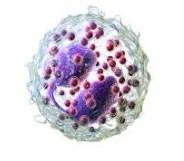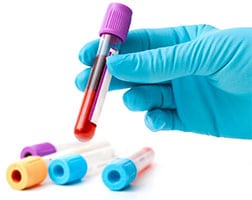 Eosinophils are small granulocytes that originate in the bone marrow. Granulocytes, for their part, are leukocytes (white cells) that have granules in their cytoplasm . This type of granulocyte remains in the blood for three to four days and then settles in the mucous membranes or epithelium of the tissues.
Eosinophils are small granulocytes that originate in the bone marrow. Granulocytes, for their part, are leukocytes (white cells) that have granules in their cytoplasm . This type of granulocyte remains in the blood for three to four days and then settles in the mucous membranes or epithelium of the tissues.
The German Paul Ehrlich , who received the Nobel Prize in Medicine , was the first doctor to describe eosinophils. In 1879 , Ehrlich observed how, using a dye called eosin , these granulocytes stained intensely. In this way he named them eosinophils.
With a nucleus that has two lobes linked through interchromatin bridges and that houses chromatin in its center, each eosinophil has about twenty granules in its cytoplasm. The granules, in turn, store different types of proteins .
Eosinophils measure between ten and twelve micrometers and usually represent 1% to 4% of the total leukocytes circulating in the blood . Among its functions is the regulation of hypersensitivity reactions and allergic responses and defense against the actions of certain microorganisms. This makes them important actors in protecting the body from infections, inflammatory processes and allergies in general.
When, in a blood test, the amount of eosinophils detected is less than 1% or more than 4% of the total white blood cells, the value is considered abnormal and could therefore reveal a health problem. .
The blood test that aims to measure the number of white blood cells is known as the absolute eosinophil count . To carry out the count, it is normal to draw blood from one of the veins located on the back of the hand or the bottom of the elbow. It is important to clean the area with an antiseptic product before performing the puncture.
The health professional must place an elastic band around the patient's forearm to put pressure on it and reduce blood flow through the vein chosen for the examination. It is only then that you can proceed to insert the needle.
 Eosinopenia appears when the eosinophil count is low. This disorder can be linked to an infection, poisoning, corticosteroid treatment, stress , aplastic anemia, Cushing's disease or HIV, for example. It is important to note that a low number of eosinophils does not necessarily cause health problems since the immune system can adequately compensate for this abnormality.
Eosinopenia appears when the eosinophil count is low. This disorder can be linked to an infection, poisoning, corticosteroid treatment, stress , aplastic anemia, Cushing's disease or HIV, for example. It is important to note that a low number of eosinophils does not necessarily cause health problems since the immune system can adequately compensate for this abnormality.
In fact, the low number of eosinophils is usually noticed in the result of a complete blood count that the doctor orders for other reasons, so it surprises him precisely because there were no symptoms that would give it away. Regarding the solution of this anomaly, it is achieved by treating the cause.
If eosinophils are at a high level, on the other hand, we speak of hypereosinophilia or eosinophilia . Possible reasons include some allergies, asthma, Churg-Strauss syndrome, allergic rhinitis, eczema, some parasitic infections , atopic dermatitis, and interstitial nephropathy.
The number of eosinophils can also increase abnormally in the presence of certain types of cancer, such as leukemia and Hodgkin lymphoma, not to mention myeloproliferative disorders. When the amount is not excessively high above normal, symptoms are few. On the other hand, in the opposite case, damage may appear in certain organs and inflammation in the tissues; The lungs, heart, nervous system and skin are the most affected parts, although problems can be seen in other parts of the body.
